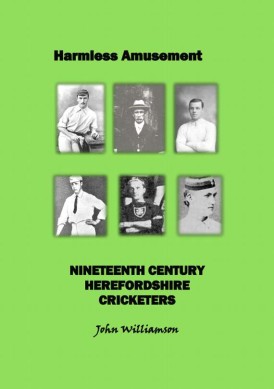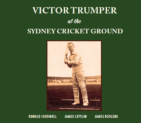Harmless Amusement
Martin Chandler |Published: 2018
Pages: 184
Author: Williamson, John
Publisher: Chapeltown Publishing
Rating: 3.5 stars

It is relatively unusual for the title of a book about cricket not to give a clue as to what its subject matter is, but Harmless Amusement is certainly one. Even the sub-title, Nineteenth Century Herefordshire Cricketers, does not help a great deal. As any avid reader of Wisden will know Herefordshire were not a part of the Minor Counties Championship until 1992, and spent by far the greater part of the twentieth century without a county club at all. So I was expecting a book full of stories about long forgotten worthies whose names, in a cricketing context at least, I had almost certainly never heard of.
Inevitably in a book of this nature there are plenty of lesser lights featured, but at the same time there is a chapter on the Grace family, which comprises an account of the cricketing links that WG and his family had with Herefordshire. One of the most interesting chapters in the book is marred slightly by the only irritation I found in the book, tragic younger brother Fred being consistently referred to by his first Christian name, George.
Grace apart there are no cricketing superstars who feature in Harmless Amusement, but I was gratified to see that the last of the 22 chapters, styled as being concerned with Herefordshire’s Greatest Ever Sportsman, was about a Lancastrian. I hadn’t realised that Jack Sharp was actually born in Hereford, but he was a fine all-rounder who was a good enough batsman to score a Test hundred against Australia and also to play twice on the right wing for England on the soccer field. Cricket literature has seldom dwelt on Sharp, and it is good to see him get a chapter to himself.
For bibliophiles, one of the men who features is Henry Bentley, a modest cricketer but a man whose name I immediately recognised as, thanks to him,we have one of the very earliest cricket books. For its time (1823) Bentley’s collection of scores of MCC matches was a mighty tome and a landmark in the game’s literature. Before reading Harmless Amusement I knew next to nothing of Bentley’s life, a gap in my knowledge that has now been rectified.
Williamson has unearthed plenty of other interesting characters for Harmless Amusement. There are a number who starred in other sports as well, mainly soccer and Rugby Union, but there is also an archer who won an Olympic silver medal. In the manner of the times most of the interesting people are amateurs, so there is a liberal sprinkling of local gentry, lawyers, clergymen and schoolmasters. That said a few professionals linked with the county, generally given men for matches against the leading wandering sides, put in an appearance as well.
Amongst those whose names will be known to some there is a chapter on FC Cobden, who gave his name to the 1870 Varsity match with some remarkable bowling. Also featured is Charles Thornton, a mighty hitter who was one of cricket’s major personalities in the Victorian era. In addition, for anyone who fears Harmless Amusement may be a little parochial, I can confirm that four Australians are featured. Two of them were Rugby Union internationals, and one went on to be the premier of New South Wales.
I have read and reviewed a few self-published books of late and, whilst the contents have, as here, invariably been impressive, not all the authors have fully got to grips with the practical side of producing a high quality product. Is Williamson any different? To be honest he’s a bit of a fraud on that one because although this is his first cricket book he has written other books and the experience shows. The way the book is set out is easy on the eye and some ancient images, that must have given rise to a few challenges, have been very well reproduced.
For those wishing to purchase Harmless Amusement the email address of the author is johnchapeltown@gmail.com The cost is £5.99 plus postage and packing which, within the UK, is a further £2.






Martin, thank you so much for your positive and generous comments on the book.This is much appreciated. Regarding “young Mister Grace”, in my defence I should point out that my great-grandmother – the delightfully named Annie Toghill Stump – was a contemporary of the Graces in Downend, and her and her brothers were well acquainted with the Grace family. Anecdotes passed to me by Annie’s son – my granddad, Arthur Harrison (I spent many hours in my young days in his shed – surrounded by hammers, chisels, Stanley knives and the smoke from Woodbines, but managed to survive to adulthood) featured her memories of the Grace clan. The youngest son was always referred to as “George” – his first given name – which is why I chose to use this style in the book. I rest my case!
John Williamson
Comment by John Williamson | 8:54am BST 6 August 2018
What a wonderful explanation – criticism withdrawn, unconditionally!
Comment by Martin Chandler | 7:25pm BST 6 August 2018